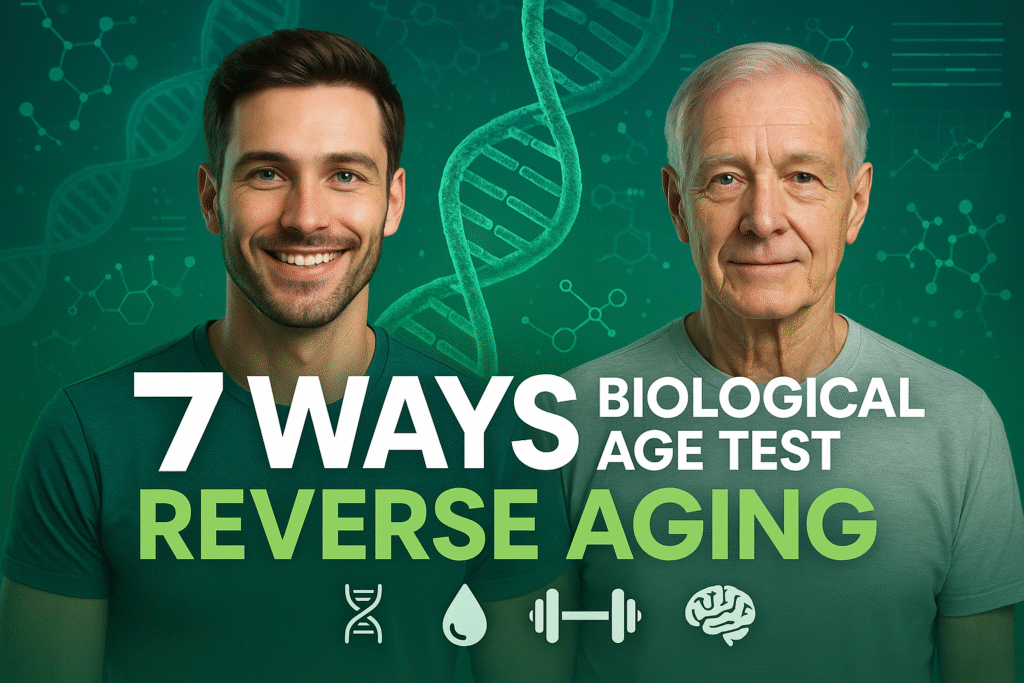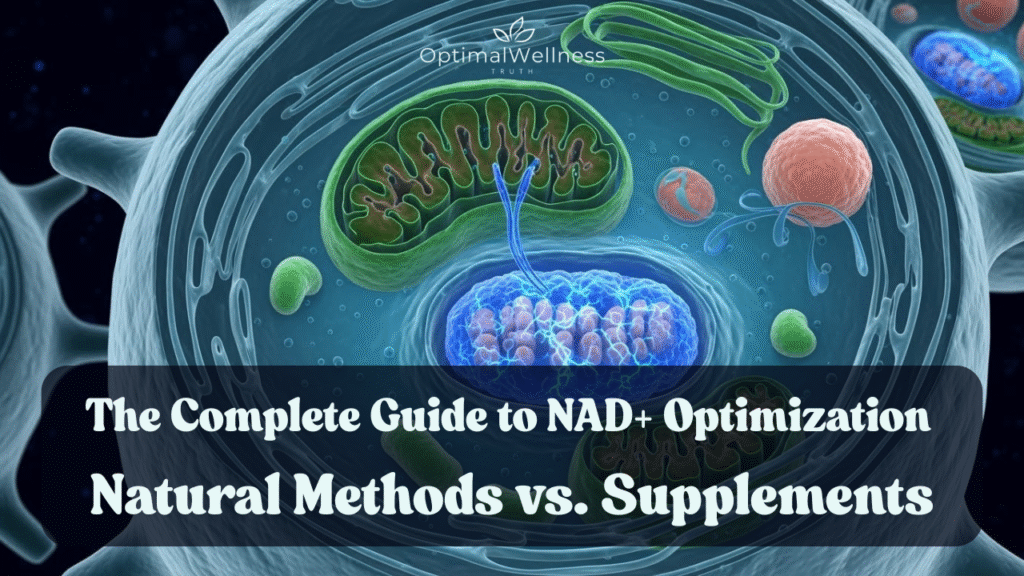OptimalWellnessTruth
Longevity and Anti-Aging
Biological Age Testing: 7 Ways to Measure and Reverse Your Cellular Age
Discover scientifically-validated methods to test your biological age and evidence-based strategies to reverse cellular aging. This comprehensive guide covers cutting-edge testing technologies and actionable interventions to optimize your healthspan.
Testing Methods
Accuracy Range
Cost Range
Table of Contents
Introduction
What if I told you that your driver’s license age might be lying about how old you really are?
Consider this striking example: you could meet two 50-year-olds at a coffee shop—one looking vibrant and energetic like they’re 35, while the other appears weathered and fatigued, resembling someone in their mid-60s. This disparity isn’t just about good genes or expensive skincare; it reflects a fundamental difference between chronological age and biological age.
Traditional aging markers have failed us for too long. While your chronological age simply counts the years since birth, your biological age reveals how well your cells, tissues, and organs are actually functioning. This distinction has profound implications for your healthspan—the number of years you live in good health—and your overall longevity.
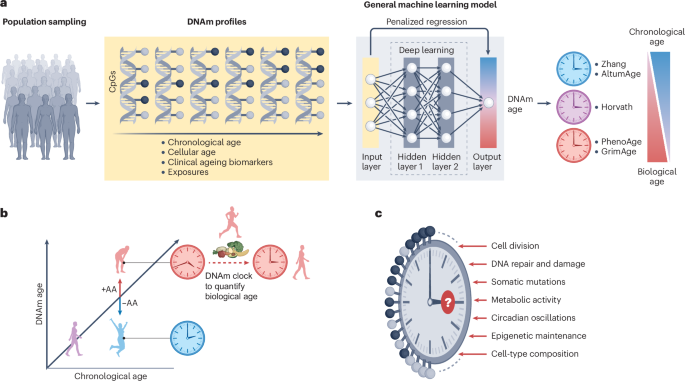
Epigenetic clocks provide accurate biological age assessment through DNA methylation patterns (Source: Nature)
The growing longevity movement, backed by groundbreaking scientific research, has made biological age testing more accessible than ever before. We’re witnessing unprecedented breakthroughs in our understanding of cellular aging, from the discovery of telomere shortening to the development of sophisticated epigenetic clocks that can predict health outcomes with remarkable accuracy.
What You’ll Discover
- 7 scientifically-backed testing methods
- Accuracy and cost comparisons
- How to choose the right test
- When to retest for optimization
Actionable Strategies
- Evidence-based reversal protocols
- NAD+ optimization techniques
- Targeted exercise interventions
- Comprehensive lifestyle modifications
Biological age represents the true state of your cellular health, determined by various aging hallmarks including telomere shortening, DNA methylation patterns, mitochondrial dysfunction, and cellular senescence. Unlike the inevitable march of chronological time, biological age can be influenced, slowed, and even reversed through targeted interventions.
Understanding Biological Age: The Science Foundation
What Is Biological Age?
Biological age refers to how old your body is physiologically, based on the condition and function of your cells, tissues, and organs. Unlike chronological age, which simply counts calendar years, biological age reflects the cumulative impact of genetics, lifestyle, environment, and disease on your body’s aging process.
This concept emerged from decades of aging research showing that people of the same chronological age can have vastly different health profiles and life expectancies. Some 60-year-olds have the cellular health of 45-year-olds, while others may have aged to the equivalent of 75 years biologically.
The Hallmarks of Aging
Modern aging science has identified several key hallmarks that drive the biological aging process:
Cellular Senescence
Over time, cells lose their ability to divide and function properly, entering a zombie-like state where they secrete inflammatory compounds that damage surrounding healthy cells.
Telomere Shortening
Telomeres are protective DNA-protein structures at chromosome ends that shorten with each cell division. When critically short, cells can no longer divide effectively.
Mitochondrial Dysfunction
The powerhouses of our cells gradually lose efficiency in energy production, leading to decreased cellular function and increased oxidative stress.
Epigenetic Alterations
Chemical modifications to DNA that affect gene expression accumulate over time, creating predictable patterns that serve as biological age clocks.
Why Measuring Biological Age Matters
Key Benefits of Biological Age Testing:
- Predictive Power: More accurate prediction of disease risk and mortality than chronological age
- Early Intervention: Identify accelerated aging before symptoms appear
- Personalized Medicine: Tailor treatments and interventions to individual aging patterns
- Progress Tracking: Monitor the effectiveness of anti-aging interventions
The 7 Methods to Test Your Biological Age
Method 1: Epigenetic Age Testing (DNA Methylation Clocks)
What it measures: DNA methylation patterns that change predictably with aging
Epigenetic age testing represents the gold standard for biological age assessment, utilizing sophisticated algorithms called “epigenetic clocks” that analyze patterns of DNA methylation—chemical modifications that accumulate on your DNA over time without changing the underlying genetic sequence.
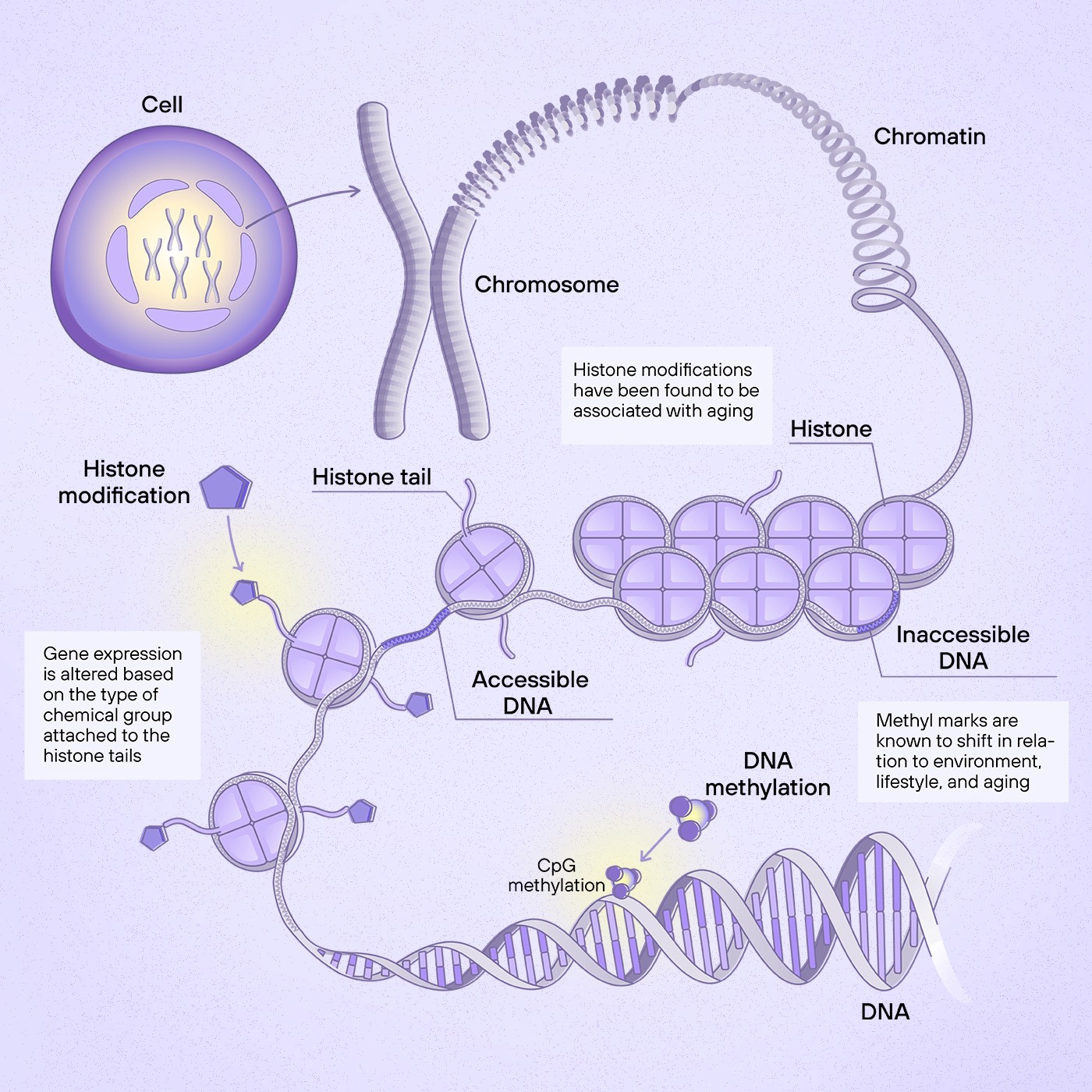
Epigenetic clocks analyze DNA methylation patterns to determine biological age (Source: VitaDAO)
How it works:
The most established clock is Horvath’s clock, which examines methylation patterns across 353 specific DNA sites. Newer clocks like GrimAge and PhenoAge incorporate additional health-related factors, providing not just age estimation but also predictions of disease risk and mortality.
Available Tests:
| Test | Company | Cost | Features |
|---|---|---|---|
| TruAge | TruDiagnostic | $499 | Multiple clocks, DunedinPACE, inflammation markers |
| myDNAge | Zymo Research | $299 | Horvath’s clock, basic biological age |
| EpiAging | Chronomics | €159 | European-based, lifestyle recommendations |
Pros & Cons
- Highest scientific validation
- Comprehensive health insights
- Can track changes over time
- Predicts disease risk
- Higher cost
- Requires laboratory processing
- Influenced by recent illness
- Complex interpretation
Method 2: Telomere Length Analysis
What it measures: The length of protective chromosome end caps (telomeres)
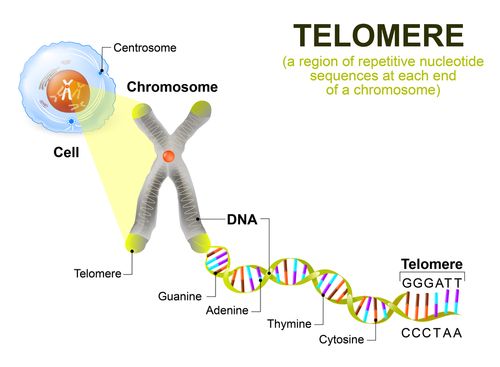
Telomeres protect chromosomes and shorten with age (Source: Vitality Medical Wellness)
Telomeres serve as molecular timekeepers, shortening with each cell division and providing insight into cellular aging. However, telomere length varies significantly between individuals and can be influenced by stress, lifestyle, and genetics.
How it works:
Testing typically uses quantitative PCR (qPCR) or Flow-FISH methods to measure average telomere length in white blood cells. The results are compared to age-matched populations to determine if your telomeres are longer or shorter than expected.
Available Tests:
| Test | Company | Cost | Method |
|---|---|---|---|
| TeloYears | RepeatDx | $199 | qPCR, percentile rankings |
| SpectraCell Test | SpectraCell | $290 | qPCR, nutritional analysis |
| Life Length TAT | Life Length | $395 | Flow-FISH, precise measurements |
Method 3: Advanced Blood Biomarker Panels
What it measures: Multiple aging-related biomarkers in blood
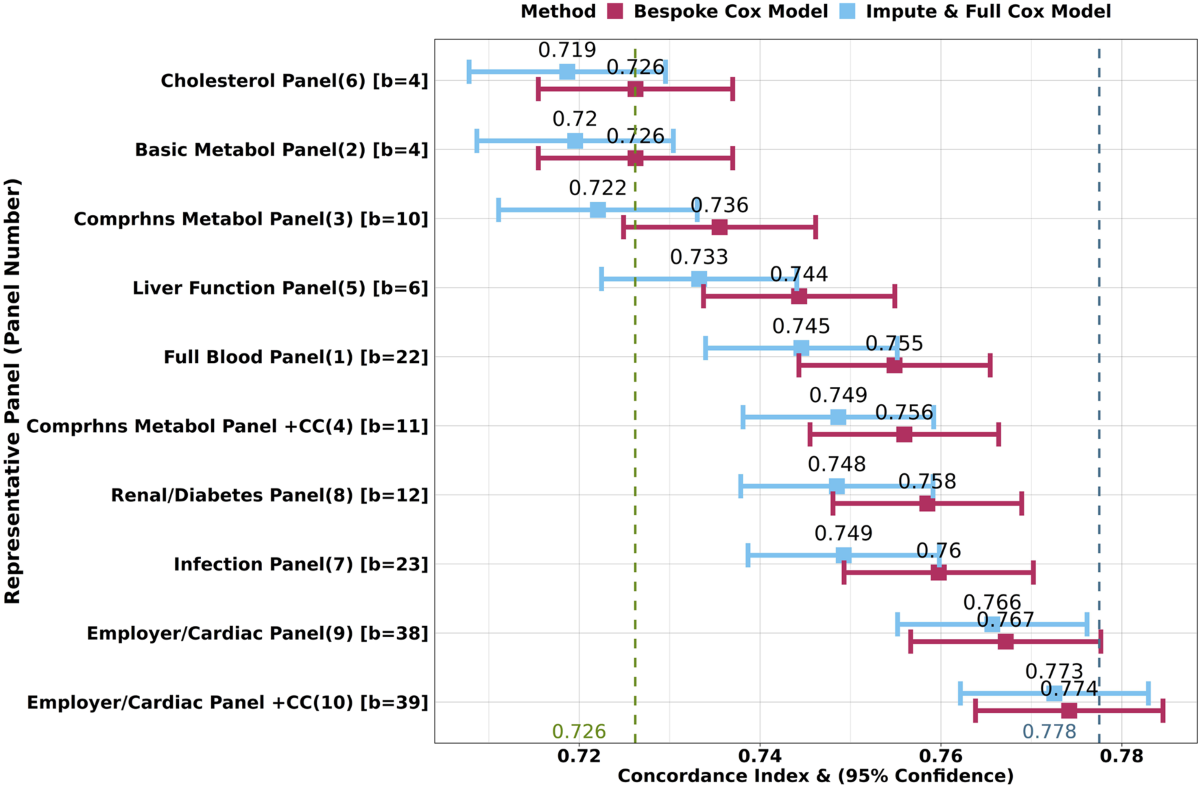
Blood biomarker analysis for biological age estimation (Source: Nature Communications)
These comprehensive panels analyze dozens of blood markers associated with aging, including inflammatory markers (CRP, IL-6), metabolic indicators (HbA1c, fasting glucose), hormonal levels (IGF-1, thyroid hormones), and cardiovascular risk factors.
Key Biomarkers Analyzed:
Inflammatory Markers
- C-Reactive Protein (CRP)
- Interleukin-6 (IL-6)
- TNF-alpha
- Homocysteine
Metabolic Indicators
- HbA1c (glucose control)
- Insulin sensitivity
- Lipid profiles
- IGF-1 levels
Leading Testing Platforms:
| Platform | Biomarkers | Cost | Special Features |
|---|---|---|---|
| InsideTracker InnerAge 2.0 | 17 (men), 13 (women) | $499/year | Personalized recommendations, tracking |
| Function Health | 100+ biomarkers | $499/year | Comprehensive panel, quarterly testing |
| SiPhox Health | 50+ biomarkers | $395 | Metabolic focus, at-home testing |
Method 4: Metabolomic Age Testing
What it measures: Small molecule metabolites in blood or urine that change with aging
Metabolomics analyzes the chemical fingerprints of metabolism, examining hundreds of small molecules that reflect cellular function, energy production, and waste processing. This emerging field shows promise for accurate biological age assessment.
How it works:
Mass spectrometry technology identifies and quantifies metabolites, which are then analyzed using machine learning algorithms trained on age-related patterns. The metabolic profile reflects real-time cellular function and aging processes.
Key Metabolic Pathways Analyzed:
- Energy Metabolism: Glucose, lactate, and ATP-related compounds
- Amino Acid Profiles: Protein synthesis and breakdown markers
- Lipid Metabolism: Fatty acid oxidation and membrane composition
- Oxidative Stress: Antioxidant capacity and damage markers
Method 5: Fitness and Functional Age Assessment
What it measures: Physical performance metrics that correlate with biological age
Functional age testing evaluates your body’s performance across multiple domains, including cardiovascular fitness, strength, balance, flexibility, and cognitive function. These assessments provide practical insights into aging that directly impact daily life.
Key Assessments:
Cardiovascular
- VO2 Max testing
- Resting heart rate
- Blood pressure response
- Recovery heart rate
Strength & Balance
- Grip strength
- Single-leg balance
- Chair stand test
- Flexibility assessment
Why Functional Age Matters:
Studies show that VO2 max is one of the strongest predictors of longevity, with each 1 mL/kg/min increase associated with a 9-15% reduction in mortality risk. Grip strength is equally predictive, with stronger individuals showing significantly lower rates of cardiovascular disease and all-cause mortality.
Method 6: AI-Powered Facial Age Analysis
What it measures: Facial aging patterns using computer vision algorithms
Recent advances in artificial intelligence have enabled accurate age estimation from facial photographs. While seemingly superficial, facial aging reflects underlying biological processes and can predict health outcomes.
How it works:
Deep learning algorithms analyze facial features, skin texture, wrinkles, and other aging markers from photographs. The technology has been trained on millions of images to identify patterns associated with biological aging.
Recent Research Breakthrough:
Harvard researchers developed FaceAge, which showed correlation with cancer treatment outcomes. Patients with younger-appearing faces had better survival rates, suggesting facial aging reflects overall biological resilience.
Method 7: Comprehensive Multi-Omic Testing
What it measures: Integrated analysis of genomics, epigenomics, proteomics, and metabolomics
The most comprehensive approach combines multiple types of biological data to create a holistic picture of biological aging. This cutting-edge method integrates DNA analysis, protein levels, metabolite profiles, and other molecular markers.
Integration Approach:
Data Types Integrated
- Genomics (DNA sequence)
- Epigenomics (methylation)
- Proteomics (protein levels)
- Metabolomics (metabolites)
- Transcriptomics (gene expression)
Advanced Analytics
- Machine learning integration
- Systems biology modeling
- Pathway analysis
- Network medicine approaches
- Personalized risk scoring
TruDiagnostic OMICm Age Clock:
The latest advancement combines epigenetic data with proteomics, achieving 87% accuracy in predicting 10-year mortality risk—outperforming traditional methylation clocks. This represents the future of biological age testing.
How to Choose the Right Test for You
Decision Framework
Selecting the optimal biological age test depends on several key factors that align with your goals, resources, and circumstances.
Budget Considerations
- Entry Level ($0-200): Functional assessments, basic biomarkers
- Intermediate ($200-500): Comprehensive blood panels, telomere testing
- Advanced ($500-1000): Epigenetic clocks, metabolomics
- Premium ($1000+): Multi-omic testing, research-grade analysis
Accuracy Requirements
- High-stakes decisions: Epigenetic or multi-omic testing
- Health optimization: Blood biomarkers or functional tests
- General wellness: Any validated method
- Tracking changes: Consistent methodology over time
Beginner vs. Advanced Testing Strategy
| Level | Recommended Tests | Cost Range | Frequency |
|---|---|---|---|
| Beginner | Functional assessment + basic blood panel | $150-300 | Every 6-12 months |
| Intermediate | Comprehensive blood panel + telomere test | $400-700 | Every 6 months |
| Advanced | Epigenetic testing + blood biomarkers | $700-1000 | Every 12 months |
| Expert | Multi-omic testing + all modalities | $1500-3000 | Every 12-18 months |
Red Flags to Avoid
- Tests making unrealistic anti-aging claims
- Companies not disclosing methodology
- Lack of peer-reviewed research backing
- Extremely low prices without explanation
- No reference to established aging clocks
- Promises of “fountain of youth” results
7 Evidence-Based Ways to Reverse Your Biological Age
Strategy 1: Optimize Cellular NAD+ Levels
NAD+ (nicotinamide adenine dinucleotide) levels decline significantly with age, contributing to mitochondrial dysfunction and cellular aging. Research shows that boosting NAD+ can improve cellular energy production and potentially reverse aspects of aging.
Natural Enhancement Methods:
- High-intensity exercise: HIIT sessions 3x/week boost NAD+ by 20-30%
- Intermittent fasting: 16:8 or 18:6 protocols activate NAD+ synthesis
- Sauna therapy: 15-20 minutes at 180-200°F, 3-4x/week
- Cold exposure: Cold showers or ice baths stimulate NAD+ production
Supplementation Options:
NMN
250-500mg daily
Clinical studies show 25-40% NAD+ increase
NR
300-600mg daily
Well-tolerated, FDA GRAS status
Niacin
100-500mg daily
Time-release forms reduce flushing
Expected Timeline:
- 2-4 weeks: Initial energy improvements
- 3-6 months: Significant cellular changes
- 6-12 months: Measurable biological age improvements
Strategy 2: Implement Targeted Exercise Protocols
Exercise is one of the most powerful interventions for reversing biological age, with specific protocols showing superior benefits for longevity and cellular health.
High-Intensity Interval Training (HIIT):
Protocol
- Work: 30 seconds at 85-95% max HR
- Rest: 90 seconds active recovery
- Repeat: 8-12 cycles
- Frequency: 2-3 sessions/week
Benefits
- Reduces epigenetic age by 3-9 years
- Improves mitochondrial biogenesis
- Enhances cardiovascular function
- Boosts growth hormone release
Zone 2 Cardio for Mitochondrial Health:
Moderate-intensity exercise at 60-70% maximum heart rate improves mitochondrial function and biogenesis. Target 150-180 minutes weekly for optimal benefits.
Resistance Training Benefits:
- Preserves muscle mass and bone density
- Maintains hormonal function
- Include compound movements 2-3x/week
- Progressive overload essential for adaptation
Strategy 3: Master Circadian Rhythm Optimization
Circadian disruption accelerates biological aging through effects on sleep quality, hormonal regulation, and cellular repair processes.
Sleep Quality Improvement:
Sleep Hygiene
- 7-9 hours nightly
- Consistent sleep-wake times
- Cool temperature (65-68°F)
- Complete darkness
Light Exposure
- Bright light within 30 min of waking
- 10,000 lux morning light therapy
- Minimize blue light 2-3 hrs before bed
- Use amber glasses if needed
Meal Timing Strategies:
- Time-restricted eating: 10-12 hour eating window
- Early dinner: Last meal 3+ hours before bed
- Consistent timing: Regular meal schedules support circadian rhythm
- Light breakfast: Avoid heavy morning meals that disrupt rhythm
Strategy 4: Nutritional Interventions
Strategic nutritional approaches can significantly impact biological aging through effects on inflammation, oxidative stress, and cellular function.
Caloric Restriction and Longevity:
Moderate caloric restriction (10-25% reduction) activates longevity pathways and has been shown to slow biological aging in multiple studies.
Intermittent Fasting Protocols:
16:8 Method
16-hour fast, 8-hour eating window
Most popular and sustainable
18:6 Method
18-hour fast, 6-hour eating window
Enhanced autophagy benefits
5:2 Method
5 normal days, 2 low-calorie days
Easier social integration
Anti-Aging Nutrients:
- Omega-3 fatty acids: 2-3g daily EPA/DHA
- Polyphenols: Berries, green tea, dark chocolate
- Cruciferous vegetables: Sulforaphane and glucosinolates
- Mediterranean pattern: Strong associations with healthy aging
Strategy 5: Stress Management and Mental Health
Chronic stress accelerates biological aging through inflammation, cortisol elevation, and telomere shortening. Effective stress management is crucial for healthy aging.
Meditation and Mindfulness Practices:
Proven Techniques
- Mindfulness meditation (10-20 min daily)
- Loving-kindness meditation
- Body scan techniques
- Breath-focused practices
Measurable Benefits
- Slows epigenetic aging
- Preserves telomere length
- Reduces inflammatory markers
- Improves stress resilience
Social Connection Importance:
Strong social relationships are among the most powerful predictors of longevity. Prioritize meaningful relationships and community involvement.
Strategy 6: Environmental Optimization
Reducing exposure to environmental toxins and optimizing your surroundings can significantly impact the aging process.
Toxin Reduction Strategies:
- Organic foods: Reduce pesticide exposure
- Water filtration: Remove chlorine, fluoride, heavy metals
- Air purification: HEPA filters for indoor air quality
- Non-toxic products: Cleaning supplies, personal care items
Indoor Environment Optimization:
Air Quality
- HEPA air purifiers
- Indoor plants for oxygen
- Regular ventilation
- VOC reduction
Sleep Environment
- EMF reduction in bedroom
- Blackout curtains
- Temperature control
- Noise reduction
Strategy 7: Targeted Supplementation
Evidence-based supplements can support healthy aging when used strategically as part of a comprehensive approach.
Core Longevity Supplements:
| Supplement | Dosage | Primary Benefits | Evidence Level |
|---|---|---|---|
| Omega-3 (EPA/DHA) | 2-3g daily | Anti-inflammatory, cardiovascular protection | High |
| Vitamin D3 | 2000-4000 IU | Immune function, bone health | High |
| Magnesium | 400-600mg | Sleep, muscle function, metabolism | High |
| NAD+ Precursors | 250-500mg | Cellular energy, DNA repair | Moderate |
| Resveratrol | 250-500mg | Sirtuin activation, antioxidant | Moderate |
Personalization Strategy:
Consider genetic testing to optimize supplement selection. For example, MTHFR variants may require methylated B-vitamins, while APOE4 carriers may benefit from higher omega-3 dosages.
Creating Your Personal Biological Age Action Plan
Step 1: Baseline Testing
Choosing Your First Test:
For most people, starting with a comprehensive blood biomarker panel provides actionable insights at reasonable cost.
Recommended Starting Protocol:
- Function Health or InsideTracker panel
- Basic functional assessments
- Progress photos and measurements
- Subjective wellness tracking
Step 2: Intervention Implementation
High-Impact Starting Points:
- Sleep optimization: 7-9 hours, consistent schedule
- Exercise protocol: 2x HIIT + 3x Zone 2 weekly
- Stress management: Daily meditation practice
- Nutrition: Mediterranean pattern + time-restriction
Step 3: Monitoring and Adjustment
Tracking Strategy:
- Weekly: Sleep, exercise, subjective energy
- Monthly: Body composition, functional tests
- Quarterly: Blood biomarkers if using Function Health
- Annually: Comprehensive biological age testing
Step 4: Advanced Optimization
Progressive Enhancement:
- Add epigenetic testing after 6-12 months
- Incorporate advanced supplementation
- Consider peptide therapy with medical supervision
- Explore emerging longevity interventions
90-Day Quick Start Plan
Days 1-30: Foundation
- Baseline testing
- Sleep optimization
- Exercise protocol start
- Basic supplementation
Days 31-60: Optimization
- Nutrition refinement
- Stress management
- Environmental improvements
- Progress assessment
Days 61-90: Integration
- Advanced interventions
- Protocol refinement
- Results evaluation
- Long-term planning
Conclusion and Next Steps
The science of biological age testing has revolutionized our understanding of aging and opened unprecedented opportunities for health optimization. Unlike the inexorable march of chronological time, biological age can be measured, tracked, and most importantly, influenced through evidence-based interventions.
Key Takeaways
- Biological age testing is now accessible and actionable
- Multiple methods offer different insights and price points
- Reversal strategies are grounded in rigorous science
- Consistency trumps perfection in implementation
- Early intervention provides the greatest benefits
Immediate Action Items
- Choose one testing method to establish baseline
- Implement 2-3 high-impact reversal strategies
- Set a 90-day review checkpoint
- Connect with healthcare providers familiar with longevity medicine
The future of longevity medicine promises even more sophisticated tools and interventions. By beginning your biological age optimization journey today, you position yourself to benefit from these advances while laying the foundation for a longer, healthier life.
Remember: Your biological age is within your control
The question isn’t whether you can influence your aging process—the science clearly shows you can. The question is whether you’ll take action to claim that control and optimize your healthspan for the decades ahead.
Scientific References and Further Reading
Epigenetic Clocks and DNA Methylation
Telomere Research
Blood Biomarkers and Metabolomics
Exercise and Aging
NAD+ and Longevity
Disclaimer
This article is for educational purposes only and should not replace professional medical advice. Always consult with qualified healthcare providers before making significant changes to your health regimen or interpreting biological age test results.

